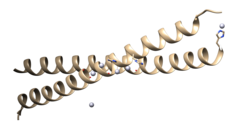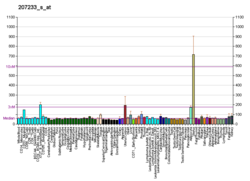小眼球症関連転写因子
小眼球症関連転写因子(しょうがんきゅうしょうかんれんてんしゃいんし、英: microphthalmia-associated transcription factor、MITF)は、ヒトではMITF遺伝子によってコードされるタンパク質である。bHLHe32(class E basic helix-loop-helix protein 32)としても知られる。
MITFは塩基性ヘリックスループヘリックス(bHLH)-ロイシンジッパー(LZ)型転写因子であり、メラノサイト、破骨細胞、マスト細胞など多くの細胞種で細胞系列特異的な経路の調節に関与している[5]。細胞系列特異的とは遺伝子または形質が特定の細胞種のみで発現することを意味する。MITFはこれらの正常な前駆体細胞の生存と生理学的機能に必要なシグナル伝達カスケードの切り替えに関与している可能性がある[6]。
MITFは、TFEB、TFE3、TFECともに、bHLH-LZ型タンパク質のサブファミリーである、MiT-TFEファミリーと呼ばれる転写因子ファミリーに属する[7][8]。これらの因子は、DNAに結合する安定なホモまたはヘテロ二量体を形成する[9]。マウスではMITFをコードする遺伝子はmi遺伝子座に位置し[10]、その標的には、細胞死、DNA複製、DNA修復、有糸分裂、miRNAの産生、膜輸送、ミトコンドリアの代謝などに関与する腫瘍形成促進性因子が含まれる[11]。この遺伝子の変異は、難聴、骨の喪失、小眼球、目や皮膚の色素の不足を引き起こす[12]。ヒトでは、MITFはメラノサイトでの正常なメラニン合成に必要不可欠なさまざまな遺伝子の発現を制御することが知られており、MITFの変異はメラノーマ、ワールデンブルグ症候群、Tietz症候群などの疾患の原因となることがある[13]。その機能は、ゼブラフィッシュ[14]やXiphophorus属[15]などの魚類を含む、脊椎動物の間で保存されている。
MITFに関する理解は、特定の細胞系列特異的ながんや他の疾患がどのように進行するかを理解するために必要である。さらに、現在および将来の研究によって、この転写因子の機構を標的としたがん予防の道が開かれる可能性がある[16]。
臨床的意義 編集
変異 編集
上述したように、MITFに変化が生じることで健康に重大な影響が生じる場合がある。例えば、MITFの変異はワールデンブルグ症候群やTietz症候群への関与が示唆されている。
ワールデンブルグ症候群は、難聴、神経堤由来構造の軽度の欠陥、色素形成の異常などの症状を示す、稀少遺伝性疾患である[17]。
Tietz症候群は1923年に最初に記載された先天性疾患で、多くの場合は難聴とリューシズムによって特徴づけられる。Tietz症候群はMITF遺伝子の変異によって引き起こされる[18]。Tietz症候群の原因となるMITF遺伝子の変異は、塩基性モチーフ領域のアミノ酸の欠失または変化を引き起こす。この変化したMITFタンパク質はDNAに結合することができず、メラノサイトの発生やその後のメラニン産生に変化が生じる。メラノサイトの数の減少は、聴力の喪失や、Tietz症候群の顕著な特徴である明るい皮膚と髪色の原因となる、メラニン産生の減少を引き起こす[13]。
メラノーマ 編集
メラノサイトは、髪、皮膚、爪を着色するメラニン色素の産生を担う細胞として一般的に知られている。メラノサイトががん細胞となる正確な機構は比較的不明瞭であるが、現在研究が進行している。例えば、メラノーマ細胞では特定の遺伝子のDNAが高頻度で損傷を受けていることが明らかにされている。この損傷の原因は紫外線照射であると考えられており、その結果メラノーマの発生の可能性が高まる[19]。具体的には、メラノーマの多くではB-RAFの遺伝子に変異が生じており、MEK-ERKキナーゼカスケードが誘導されている[20]。MITFは浸潤性、遊走、転移と関係した遺伝子の調節に関与する転写因子であるため、B-RAFに加えてMITFもメラノーマのプログレッションに大きな役割を果たしていることが知られている。MITFの標的遺伝子は次節に示す。
標的遺伝子 編集
MITFは、標的遺伝子のプロモーター領域のE-box(CAYRTG)とM-box(TCAYRTGまたはCAYRTGA)配列を認識する。既知の(少なくとも2つの独立した文献で確認されている)標的遺伝子には次のようなものがある。
| ACP5[21][22] | BCL2[22][23] | BEST1[22][24] | BIRC7[22][25] |
| CDK2[22][26] | CLCN7[22][27] | DCT[22][28] | EDNRB[22][29] |
| GPNMB[22][30] | GPR143[22][31] | MC1R[22][32] | MLANA[22][33] |
| OSTM1[22][27] | RAB27A[22][34] | SILV[22][33] | SLC45A2[22][35] |
| TBX2[22][36] | TRPM1[22][37] | TYR[22][38] | TYRP1[22][39] |
これらに加えて、次に挙げる因子がマイクロアレイ研究[22]によって同定されている。
| MBP | TNFRSF14 | IRF4 | RBM35A |
| PLA1A | APOLD1 | KCNN2 | INPP4B |
| CAPN3 | LGALS3 | GREB1 | FRMD4B |
| SLC1A4 | TBC1D16 | GMPR | ASAH1 |
| MICAL1 | TMC6 | ITPKB | SLC7A8 |
LysRS-Ap4A-MITFシグナル伝達経路 編集
LysRS-Ap4A-MITFシグナル伝達経路はマスト細胞で最初に発見された。マスト細胞ではアレルゲン刺激に伴って、免疫グロブリンEが高親和性IgE受容体(FcεRI)に結合することで、MAPK経路のカスケードが開始される。
リジルtRNAシンテターゼ(LysRS)は通常、複数のシンテターゼからなる複合体中に存在する。この複合体は9つの異なるアミノアシルtRNAシンテターゼと3つの足場タンパク質から構成され、触媒作用とは別にシグナル伝達機能を持つことから「シグナロソーム」(signalosome)と呼ばれている[40]。活性化後、LysRSはセリン207番がMAPK依存的にリン酸化される[41]。このリン酸化はLysRSのコンフォメーション変化、複合体からの脱離と核内への移行を引き起こし、そこでMITFとその活性を阻害するHINT1からなる複合体と結合する。また、コンフォメーション変化によってLysRSの活性はリジンtRNAのアミノアシル化からジアデノシン四リン酸(Ap4A)の産生へと切り替えられる。Ap4Aは2つのアデノシンが5‘-5’四リン酸で連結された分子であり、HINT1に結合してMITFを阻害複合体から解離させ、MITFの標的遺伝子の転写を可能にする[42]。具体的には、Ap4AはHINT1分子のフィラメントへの重合を引き起こし、重合によってMITFへの相互作用面が遮断されることで、両者の相互作用が妨げられる。この機構はAp4A分子のリン酸ブリッジの正確な長さに依存しており、ATPやAMPなど他のヌクレオチドは影響を与えない[43]。
MITFはメラノサイトでも重要な役割を果たしており、そこでメラニン産生に関わる多数のタンパク質の発現を調節している。MITFの特定レベルの継続的な発現は、メラノーマ細胞の増殖と生存、そしてT細胞によるメラノーマ関連抗原(melan-A)の認識の回避に必要な因子の1つである[44]。HINT1分子の翻訳後修飾は、Ap4A分子の結合とともにMITFの標的遺伝子の発現に影響を与えることが示されている[45]。HINT1自身の変異は軸索型ニューロパチーの原因となることが示されている[46]。この経路の調節はNudixファミリーに属するジアデノシン四リン酸ヒドロラーゼNUDT2によるAp4Aの切断に依存しており、HINT1のMITFへの結合を可能にしてMITFの標的遺伝子の発現を抑制する[47]。NUDT2自身はヒトの乳がんと関係していることが示されており、細胞増殖を促進する[48]。この酵素の大きさは17 kDaで、核と細胞質の間を自由に拡散するため、核内にも存在する。また、マスト細胞の免疫刺激に伴って、インポーチン-βのN末端ドメインと直接相互作用して核内へ能動輸送されることも示されている。LysRS-Ap4A-MITFシグナル伝達経路が実際にMITFの転写活性の制御の重要な側面であることを示す証拠は蓄積している[49]。
心筋細胞では、イソプロテレノールによってLysRS-Ap4A-MITFシグナル伝達経路が活性化されることが確認されている。MITFの心臓特異的アイソフォームは、心臓の成長とβアドレナリン受容体刺激に対する生理的応答を担う、心筋の成長と肥大の主要な調節因子である[50]。
リン酸化 編集
MITFはいくつかのセリン残基とチロシン残基がリン酸化される[51][52][53]。セリンのリン酸化は、MAPK/BRAF/ERK、受容体型チロシンキナーゼKIT、GSK-3、mTORなどいくつかのシグナル伝達経路によって調節される。PI3K、AKT、SRC、p38などのキナーゼはMITFのリン酸化による活性化因子として重要である[54]。対照的に、チロシンのリン酸化はKITにD816V変異が存在する場合に誘導される[53]。このKITD816V経路はSrcファミリーの活性化によるシグナル伝達に依存している。メラノーマで高頻度で変化が生じているMAPK/BRAF経路やGSK-3経路によるセリンのリン酸化の誘導はMITFの核外搬出を調節し、それによって核内でのMITFの活性を低下させる[55]。同様に、KITのD816V変異によって媒介されるチロシンのリン酸化もMITFの細胞質での存在を増加させる[53]。
相互作用 編集
大部分の転写因子は、タンパク質間相互作用によって他の因子と協働して機能する。MITFと他のタンパク質との結合は、MITFを介した転写活性の調節の重要な段階である。MAZR、PIAS3、TFE3、UBC9、PKCI-1、LEF1などとの相互作用は広く研究されている。
MAZR(Myc-associated zinc-finger protein related factor)はMITFのLZドメインと相互作用する。共に発現した場合には、MAZRとMITFの双方がマウスのmMCP-6遺伝子のプロモーター活性を増加させる。MAZRとMITFは共にmMCP-6遺伝子をトランス活性化する。また、MAZRはMITFとともにマスト細胞の形質発現にも関与している[56]。
PIAS3はSTAT3のDNA結合活性を阻害することで作用する転写阻害因子である。PIAS3はMITFと直接相互作用し、STAT3はこの相互作用には干渉しない。PIAS3はMITFの転写活性を抑制する重要な分子としても機能する。これはマスト細胞とメラノサイトの発生に重要である[57]。
MITF、TFE3、TFEBは転写因子のbHLH-LZファミリーに属する[7][9]。この転写因子ファミリーの各タンパク質はDNAに結合する。TFE3は破骨細胞の発生に必要であり、その機能はMITFとの冗長性があることが示唆されている。双方の遺伝子を喪失すると重度の大理石骨病が引き起こされ、MITFがこの転写因子ファミリーの他のメンバーと相互作用することが示されている[58][59]。TFEBはリソソーム生合成とオートファジーの主要調節因子である[60][61]。興味深いことに、MITF、TFEB、TFE3は飢餓誘導性のオートファジーの調節に個別の役割があることがメラノーマ細胞で記載されている[62]。さらに、MITFとTFEBは互いのmRNAとタンパク質発現を直接調節している一方で、細胞内局在や転写活性はmTORシグナル伝達経路など類似した経路による調節を受ける[8]。
UBC9はMITFと結合するユビキチン結合酵素である。ヒトのUBC9はSENTRIN/SUMO1と選択的に作用することが知られているが、in vitroでの解析ではMITFはSUMO1よりもユビキチンと結合することが示されている。UBC9はメラノサイトの分化の重要な調節因子であり、そのためにMITFをプロテアソームによる分解の標的とする[63]。
PKCI-1(protein kinase C-interacting protein 1)はMITFと結合する。この結合はマスト細胞の活性化に伴って減少する。PKCI-1は細胞質基質と核に存在するが、その生理学的機能は未知である。しかし、MITFの転写活性を抑制する能力を持ち、in vivoでMITFによる転写活性の負の調節因子として機能する[64]。
MITFとLEF1( lymphoid enhancing factor 1)の機能的協働は、初期のメラノブラストのマーカーであるDCT遺伝子のプロモーターを相乗的にトランス活性化する。LEF1はWntシグナルによる調節過程に関与している。LEF1はTFE3など他のMITF関連タンパク質とも協働する。MITFはLEF1の調節因子であり、多くの細胞でこの調節はWntシグナルの効率的な増幅を保証している[28]。
翻訳調節 編集
MITFの翻訳調節は、2019年時点でその重要性を示す査読済み論文は2報しかない未探索の領域である[65][66]。メラノーマ細胞では、グルタミン枯渇時にATF4の転写産物が増加するとともに、eIF2αのリン酸化によってmRNAの翻訳も増加する[65]。この分子イベントの連鎖は2つの階層でMITFを抑制する。まずATF4タンパク質はMITFに結合して転写を抑制し、さらにeIF2αはおそらくeIF2Bの阻害を介してMITFの翻訳を遮断する。
MITFはRNAヘリカーゼDDX3Xによる直接的な翻訳調節も受ける[66]。MITFの5' UTRには重要な調節エレメント(IRES)が存在し、DDX3Xによって認識、結合、活性化される。MITFの5' UTRはわずか123ヌクレオチドから構成されるが、この領域は複数の分岐を持つループや非対称的なバルジを持つ、エネルギー的に有利な二次構造へと折りたたまれることが予測されている。DDX3Xによるこのシス調節配列の活性化は、メラノーマ細胞でのMITFの発現を促進する[66]。
出典 編集
- ^ a b c GRCh38: Ensembl release 89: ENSG00000187098 - Ensembl, May 2017
- ^ a b c GRCm38: Ensembl release 89: ENSMUSG00000035158 - Ensembl, May 2017
- ^ Human PubMed Reference:
- ^ Mouse PubMed Reference:
- ^ “Mitf and Tfe3: members of a b-HLH-ZIP transcription factor family essential for osteoclast development and function”. Bone 34 (4): 689–96. (April 2004). doi:10.1016/j.bone.2003.08.014. PMID 15050900.
- ^ “Lineage dependency and lineage-survival oncogenes in human cancer”. Nature Reviews. Cancer 6 (8): 593–602. (August 2006). doi:10.1038/nrc1947. PMID 16862190.
- ^ a b “microphthalmia, a critical factor in melanocyte development, defines a discrete transcription factor family”. Genes & Development 8 (22): 2770–80. (November 1994). doi:10.1101/gad.8.22.2770. PMID 7958932.
- ^ a b “MITF and TFEB cross-regulation in melanoma cells”. PLOS ONE 15 (9): e0238546. (2020-09-03). doi:10.1371/journal.pone.0238546. PMC 7470386. PMID 32881934.
- ^ a b “Mechanism of conditional partner selectivity in MITF/TFE family transcription factors with a conserved coiled coil stammer motif”. Nucleic Acids Research 48 (2): 934–948. (January 2020). doi:10.1093/nar/gkz1104. PMC 6954422. PMID 31777941.
- ^ “A helix-loop-helix transcription factor-like gene is located at the mi locus”. The Journal of Biological Chemistry 268 (28): 20687–90. (October 1993). doi:10.1016/S0021-9258(19)36830-9. PMID 8407885.
- ^ “Fifteen-year quest for microphthalmia-associated transcription factor target genes”. Pigment Cell & Melanoma Research 23 (1): 27–40. (February 2010). doi:10.1111/j.1755-148X.2009.00653.x. PMID 19995375.
- ^ “Insight into the microphthalmia gene”. Trends in Genetics 11 (11): 442–8. (November 1995). doi:10.1016/s0168-9525(00)89143-x. PMID 8578601.
- ^ a b “MITF gene”. Genetics Home Reference. National Institutes of Health, U.S. Department of Health & Human Services. 2021年11月22日閲覧。
- ^ “nacre encodes a zebrafish microphthalmia-related protein that regulates neural-crest-derived pigment cell fate”. Development 126 (17): 3757–67. (September 1999). doi:10.1242/dev.126.17.3757. PMID 10433906.
- ^ “MITF-M plays an essential role in transcriptional activation and signal transduction in Xiphophorus melanoma”. Gene 320: 117–26. (November 2003). doi:10.1016/s0378-1119(03)00817-5. PMID 14597395.
- ^ “The complex relationship between MITF and the immune system: a Melanoma ImmunoTherapy (response) Factor?”. Mol Cancer 19 (1): 170. (December 2020). doi:10.1186/s12943-020-01290-7. PMC 7718690. PMID 33276788.
- ^ “Waardenburg syndrome: A rare genetic disorder, a report of two cases”. Indian Journal of Human Genetics 18 (2): 254–5. (May 2012). doi:10.4103/0971-6866.100804. PMC 3491306. PMID 23162308.
- ^ “Tietz syndrome (hypopigmentation/deafness) caused by mutation of MITF”. Journal of Medical Genetics 37 (6): 446–8. (June 2000). doi:10.1136/jmg.37.6.446. PMC 1734605. PMID 10851256.
- ^ "Melanoma Skin Cancer. " American Cancer Society, 29. Oct. 2014. Web. 15 October 2014. <http://www.cancer.org/acs/groups/cid/documents/webcontent/003120-pdf.pdf>
- ^ “The role of BRAF V600 mutation in melanoma”. Journal of Translational Medicine 10: 85. (July 2012). doi:10.1186/1479-5876-10-85. PMC 3391993. PMID 22554099.
- ^ “The microphthalmia transcription factor regulates expression of the tartrate-resistant acid phosphatase gene during terminal differentiation of osteoclasts”. Journal of Bone and Mineral Research 15 (3): 451–60. (March 2000). doi:10.1359/jbmr.2000.15.3.451. PMID 10750559.
- ^ a b c d e f g h i j k l m n o p q r s t u “Novel MITF targets identified using a two-step DNA microarray strategy”. Pigment Cell & Melanoma Research 21 (6): 665–76. (December 2008). doi:10.1111/j.1755-148X.2008.00505.x. PMID 19067971.
- ^ “Bcl2 regulation by the melanocyte master regulator Mitf modulates lineage survival and melanoma cell viability”. Cell 109 (6): 707–18. (June 2002). doi:10.1016/S0092-8674(02)00762-6. PMID 12086670.
- ^ “VMD2 promoter requires two proximal E-box sites for its activity in vivo and is regulated by the MITF-TFE family”. The Journal of Biological Chemistry 282 (3): 1838–50. (January 2007). doi:10.1074/jbc.M609517200. PMID 17085443.
- ^ “Microphthalmia-associated transcription factor is a critical transcriptional regulator of melanoma inhibitor of apoptosis in melanomas”. Cancer Research 68 (9): 3124–32. (May 2008). doi:10.1158/0008-5472.CAN-07-6622. PMID 18451137.
- ^ “Critical role of CDK2 for melanoma growth linked to its melanocyte-specific transcriptional regulation by MITF”. Cancer Cell 6 (6): 565–76. (December 2004). doi:10.1016/j.ccr.2004.10.014. PMID 15607961.
- ^ a b “The expression of Clcn7 and Ostm1 in osteoclasts is coregulated by microphthalmia transcription factor”. The Journal of Biological Chemistry 282 (3): 1891–904. (January 2007). doi:10.1074/jbc.M608572200. PMID 17105730.
- ^ a b “Microphthalmia-associated transcription factor interacts with LEF-1, a mediator of Wnt signaling”. The EMBO Journal 21 (11): 2703–14. (June 2002). doi:10.1093/emboj/21.11.2703. PMC 126018. PMID 12032083.
- ^ “Epistatic connections between microphthalmia-associated transcription factor and endothelin signaling in Waardenburg syndrome and other pigmentary disorders”. FASEB Journal 22 (4): 1155–68. (April 2008). doi:10.1096/fj.07-9080com. PMID 18039926.
- ^ “Gpnmb is a melanoblast-expressed, MITF-dependent gene”. Pigment Cell & Melanoma Research 22 (1): 99–110. (February 2009). doi:10.1111/j.1755-148X.2008.00518.x. PMC 2714741. PMID 18983539.
- ^ “The microphthalmia transcription factor (Mitf) controls expression of the ocular albinism type 1 gene: link between melanin synthesis and melanosome biogenesis”. Molecular and Cellular Biology 24 (15): 6550–9. (August 2004). doi:10.1128/MCB.24.15.6550-6559.2004. PMC 444869. PMID 15254223.
- ^ “Involvement of microphthalmia-associated transcription factor (MITF) in expression of human melanocortin-1 receptor (MC1R)”. Life Sciences 71 (18): 2171–9. (September 2002). doi:10.1016/S0024-3205(02)01996-3. PMID 12204775.
- ^ a b “MLANA/MART1 and SILV/PMEL17/GP100 are transcriptionally regulated by MITF in melanocytes and melanoma”. The American Journal of Pathology 163 (1): 333–43. (July 2003). doi:10.1016/S0002-9440(10)63657-7. PMC 1868174. PMID 12819038.
- ^ “Microphthalmia-associated transcription factor regulates RAB27A gene expression and controls melanosome transport”. The Journal of Biological Chemistry 283 (18): 12635–42. (May 2008). doi:10.1074/jbc.M800130200. PMID 18281284.
- ^ “Identification of Aim-1 as the underwhite mouse mutant and its transcriptional regulation by MITF”. The Journal of Biological Chemistry 277 (1): 402–6. (January 2002). doi:10.1074/jbc.M110229200. PMID 11700328.
- ^ “The gene encoding the T-box factor Tbx2 is a target for the microphthalmia-associated transcription factor in melanocytes”. The Journal of Biological Chemistry 275 (29): 21920–7. (July 2000). doi:10.1074/jbc.M000035200. PMID 10770922.
- ^ “Transcriptional regulation of the melanoma prognostic marker melastatin (TRPM1) by MITF in melanocytes and melanoma”. Cancer Research 64 (2): 509–16. (January 2004). doi:10.1158/0008-5472.CAN-03-2440. PMID 14744763.
- ^ “Signaling and transcriptional regulation in the neural crest-derived melanocyte lineage: interactions between KIT and MITF”. Development 127 (24): 5379–89. (December 2000). doi:10.1242/dev.127.24.5379. PMID 11076759.
- ^ “Selective down-regulation of tyrosinase family gene TYRP1 by inhibition of the activity of melanocyte transcription factor, MITF”. Nucleic Acids Research 30 (14): 3096–106. (July 2002). doi:10.1093/nar/gkf424. PMC 135745. PMID 12136092.
- ^ “Hierarchical network between the components of the multi-tRNA synthetase complex: implications for complex formation”. The Journal of Biological Chemistry 281 (50): 38663–7. (December 2006). doi:10.1074/jbc.M605211200. PMID 17062567.
- ^ “LysRS serves as a key signaling molecule in the immune response by regulating gene expression”. Molecular Cell 34 (5): 603–11. (June 2009). doi:10.1016/j.molcel.2009.05.019. PMID 19524539.
- ^ “The function of lysyl-tRNA synthetase and Ap4A as signaling regulators of MITF activity in FcepsilonRI-activated mast cells”. Immunity 20 (2): 145–51. (February 2004). doi:10.1016/S1074-7613(04)00020-2. PMID 14975237.
- ^ “4A polymerizes target protein HINT1 to transduce signals in FcεRI-activated mast cells”. Nature Communications 10 (1): 4664. (October 2019). doi:10.1038/s41467-019-12710-8. PMC 6789022. PMID 31604935.
- ^ “Melanoma biology and new targeted therapy”. Nature 445 (7130): 851–7. (February 2007). Bibcode: 2007Natur.445..851G. doi:10.1038/nature05661. PMID 17314971.
- ^ “Post-translational modification of HINT1 mediates activation of MITF transcriptional activity in human melanoma cells”. Oncogene 36 (33): 4732–4738. (August 2017). doi:10.1038/onc.2017.81. PMID 28394346.
- ^ “Loss-of-function mutations in HINT1 cause axonal neuropathy with neuromyotonia”. Nature Genetics 44 (10): 1080–3. (October 2012). doi:10.1038/ng.2406. PMID 22961002.
- ^ “Diadenosine tetraphosphate hydrolase is part of the transcriptional regulation network in immunologically activated mast cells”. Molecular and Cellular Biology 28 (18): 5777–84. (September 2008). doi:10.1128/MCB.00106-08. PMC 2546939. PMID 18644867.
- ^ “Nudix-type motif 2 in human breast carcinoma: a potent prognostic factor associated with cell proliferation”. International Journal of Cancer 128 (8): 1770–82. (April 2011). doi:10.1002/ijc.25505. PMID 20533549.
- ^ “Importin beta plays an essential role in the regulation of the LysRS-Ap(4)A pathway in immunologically activated mast cells”. Molecular and Cellular Biology 31 (10): 2111–21. (May 2011). doi:10.1128/MCB.01159-10. PMC 3133347. PMID 21402779.
- ^ “Transcription factor MITF regulates cardiac growth and hypertrophy”. The Journal of Clinical Investigation 116 (10): 2673–81. (October 2006). doi:10.1172/JCI27643. PMC 1570375. PMID 16998588.
- ^ “MAP kinase links the transcription factor Microphthalmia to c-Kit signalling in melanocytes”. Nature 391 (6664): 298–301. (January 1998). Bibcode: 1998Natur.391..298H. doi:10.1038/34681. PMID 9440696.
- ^ “c-Kit triggers dual phosphorylations, which couple activation and degradation of the essential melanocyte factor Mi”. Genes & Development 14 (3): 301–12. (February 2000). PMC 316361. PMID 10673502.
- ^ a b c “D816V Induces SRC-Mediated Tyrosine Phosphorylation of MITF and Altered Transcription Program in Melanoma”. Molecular Cancer Research 15 (9): 1265–1274. (September 2017). doi:10.1158/1541-7786.MCR-17-0149. PMID 28584020.
- ^ “C-KIT signaling depends on microphthalmia-associated transcription factor for effects on cell proliferation”. PLOS ONE 6 (8): e24064. (2011-08-24). Bibcode: 2011PLoSO...624064P. doi:10.1371/journal.pone.0024064. PMC 3161112. PMID 21887372.
- ^ “BRAF/MAPK and GSK3 signaling converges to control MITF nuclear export”. Proceedings of the National Academy of Sciences of the United States of America 115 (37): E8668–E8677. (September 2018). doi:10.1073/pnas.1810498115. PMC 6140509. PMID 30150413.
- ^ “Interaction and cooperation of mi transcription factor (MITF) and myc-associated zinc-finger protein-related factor (MAZR) for transcription of mouse mast cell protease 6 gene”. The Journal of Biological Chemistry 277 (10): 8566–71. (March 2002). doi:10.1074/jbc.M110392200. PMID 11751862.
- ^ “A new role for the STAT3 inhibitor, PIAS3: a repressor of microphthalmia transcription factor”. The Journal of Biological Chemistry 277 (3): 1962–6. (January 2002). doi:10.1074/jbc.M109236200. PMID 11709556.
- ^ “Mitf and Tfe3, two members of the Mitf-Tfe family of bHLH-Zip transcription factors, have important but functionally redundant roles in osteoclast development”. Proceedings of the National Academy of Sciences of the United States of America 99 (7): 4477–82. (April 2002). Bibcode: 2002PNAS...99.4477S. doi:10.1073/pnas.072071099. PMC 123673. PMID 11930005.
- ^ “The microphthalmia transcription factor and the related helix-loop-helix zipper factors TFE-3 and TFE-C collaborate to activate the tartrate-resistant acid phosphatase promoter”. Journal of Leukocyte Biology 71 (2): 304–10. (February 2002). PMID 11818452.
- ^ “A gene network regulating lysosomal biogenesis and function”. Science 325 (5939): 473–7. (July 2009). doi:10.1126/science.1174447. PMID 19556463.
- ^ “Characterization of the CLEAR network reveals an integrated control of cellular clearance pathways”. Human Molecular Genetics 20 (19): 3852–66. (October 2011). doi:10.1093/hmg/ddr306. PMID 21752829.
- ^ “MITF has a central role in regulating starvation-induced autophagy in melanoma”. Scientific Reports 9 (1): 1055. (January 2019). doi:10.1038/s41598-018-37522-6. PMC 6355916. PMID 30705290.
- ^ “Regulation of microphthalmia-associated transcription factor MITF protein levels by association with the ubiquitin-conjugating enzyme hUBC9”. Experimental Cell Research 255 (2): 135–43. (March 2000). doi:10.1006/excr.2000.4803. PMID 10694430.
- ^ “Suppression of microphthalmia transcriptional activity by its association with protein kinase C-interacting protein 1 in mast cells”. The Journal of Biological Chemistry 274 (48): 34272–6. (November 1999). doi:10.1074/jbc.274.48.34272. PMID 10567402.
- ^ a b “Translation reprogramming is an evolutionarily conserved driver of phenotypic plasticity and therapeutic resistance in melanoma”. Genes & Development 31 (1): 18–33. (January 2017). doi:10.1101/gad.290940.116. PMC 5287109. PMID 28096186.
- ^ a b c “The X-Linked DDX3X RNA Helicase Dictates Translation Reprogramming and Metastasis in Melanoma”. Cell Reports 27 (12): 3573–3586.e7. (June 2019). doi:10.1016/j.celrep.2019.05.069. PMID 31216476.





